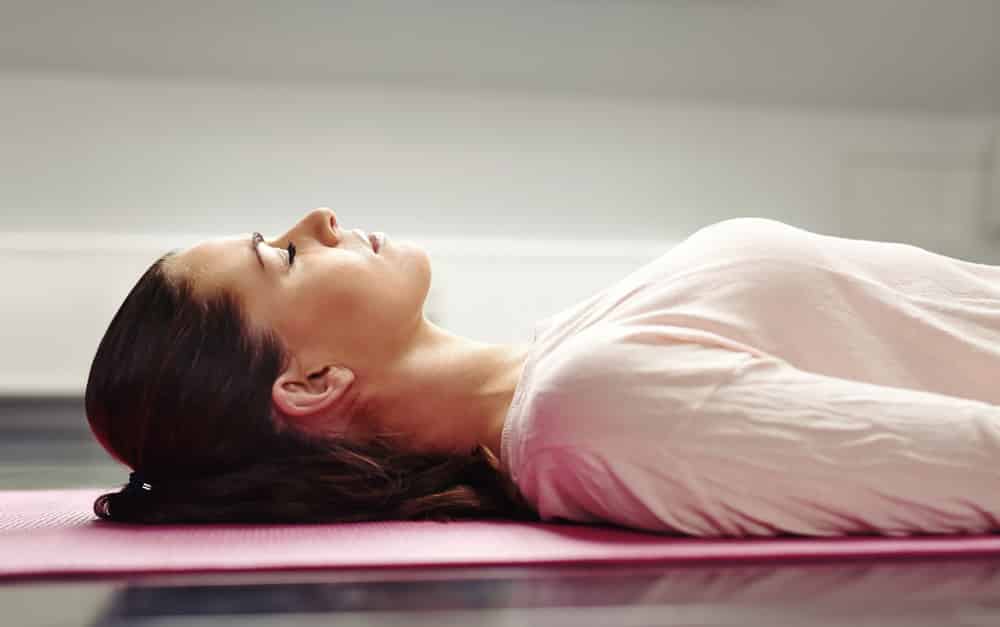Many of us have experienced those restless nights, where those things that stressed us out during the day have somehow become a thousand times worse in our heads by 2am. Anxiety and insomnia can be completely debilitating, and cannot be ignored. There are many ways to deal with severe anxiety, from medication and counselling to meditation and exercise. Whether you suffer from crippling anxiety or simply can’t switch off at night, these eight yoga poses will help you drift off. However, if you do have a severe case, be sure to seek professional help.

The Impact Of Stress & Insomnia
Stress, anxiety and insomnia are common emotions that plague some people more than others. Certain circumstances, levels of health, and environmental pressures like work and other commitments can accelerate it. A healthy diet, healthy lifestyle, exercise, medication or even special mattress and weighted blankets can help to relieve insomnia. Yoga can be particularly beneficial in helping to ease the mind and relax the body, which are crucial for deep sleep. The physical asanas (postures) of the ancient practice, mixed with breathing techniques and meditation, can calm the mind, bring perspective and help you deal with anxiety-related insomnia for mental clarity and inner peace.
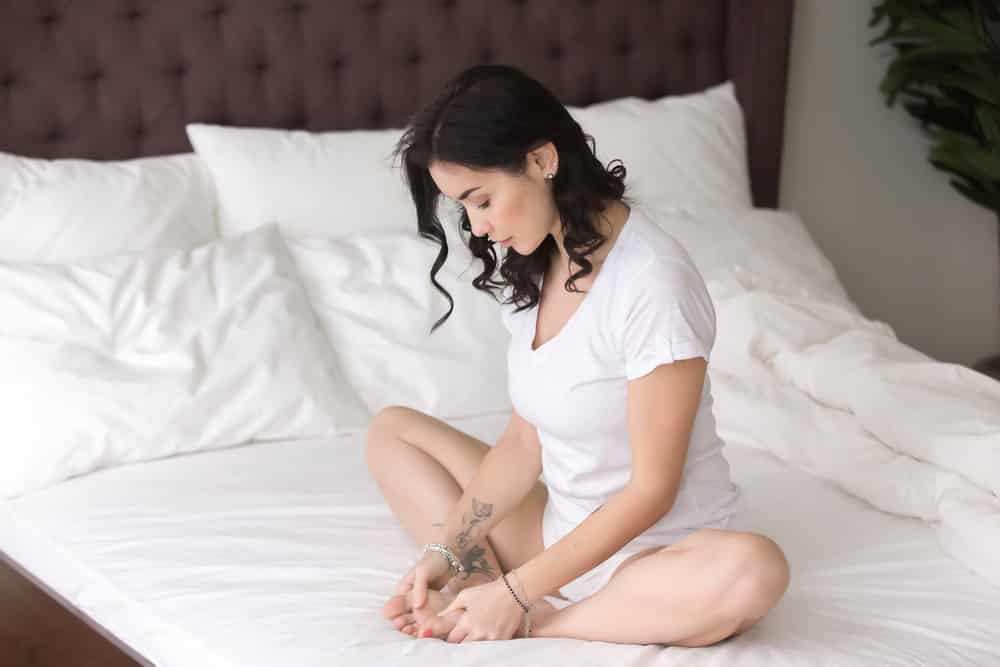
Anxiety and insomnia don’t just affect your mental state. There is a physical response to stress within the body that can actually cause physical health problems. And, everyone knows that not getting enough sleep has a detrimental impact on physical health and functionality. Our response to stressful situations comes from an automatic ‘fight or slight’ instinctual trigger, which releases a surge of adrenaline. This protected our ancestors from life-threatening danger, and remains a common reaction of chronic worriers. When the body issues this response, stress hormones, such as cortisol, are released by the sympathetic nervous system, which would be used as fuel in an actual ‘fight or flight’ scenario. The hormones boost blood sugar levels and blood fats. For people with chronic anxiety, night time can be a particularly challenging time, because when you are in bed and there is silence, your mind can run wild, and often takes you to those dark terrifying places. When you have dealt with chronic anxiety and insomnia for a while, it can even become a feeling you have, without an actual thought in your mind. Even bedtime can start to trigger that uneasy feeling when you’ve struggled to drift off to sleep for a while, because the body and mind knows you are going to be fighting with your conscience for the next few hours.

The short-term physical effects of stress can include difficulty swallowing, dizziness, dry mouth, nausea, fatigue, an increased heart rate, headaches, muscle aches and tension, lack of concentration, shortness of breath, sweating and hot flushes, trembling, nervous energy, and the thing we are concentrating on here, insomnia or difficulty getting to sleep. When the hormones and reactions continue on a repeat basis, more long-term health problems can actually develop. These include a weakened immune system, digestive problems, short-term memory loss, premature coronary artery disease, and potentially even heart attacks. If ongoing insomnia and anxiety is left untreated, it can lead to depression and suicidal feelings.
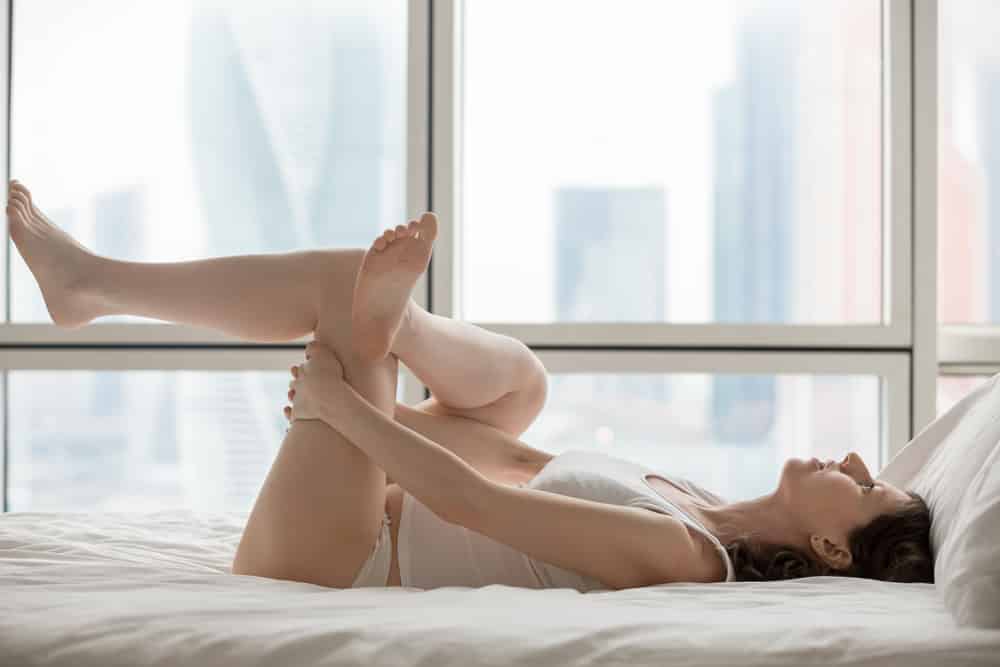
How Yoga Can Help You Relax
Yoga has many benefits beyond relaxing the body and helping you sleep. It aids with weight loss, improves circulation, increases flexibility and boosts respiratory function. When it comes to stress reduction and aiding with sleep, not all yoga poses are created equal. Some sequences are better for waking you up in the morning and increasing energy, such as heart opener postures. If you practice a morning heart opener class before bed, it could actually hinder sleep, rather than helping.

Yoga Poses To Practice Before Bed
There are a few particularly beneficial yoga poses for relaxation, winding down and restoration. Depending on what is keeping you up at night, some are more beneficial than others. For example, if you do tend to become anxious at night, breathing techniques and tension relieving poses can really help. Here are eight poses to try before bed. You can do all of them, or pick three or four each night.
Yogic Breathing
But, before we get into the actual poses, it’s a great idea to relax and practice yogic breathing, or, ujjayi breath, beforehand, and you can then carry that through the poses. By slowing the breath, you can slow down your heart rate and draw focus away from racing thoughts in your mind.
Child’s Pose
Next, move into this restful, comforting, restorative asana. Child’s pose is designed to ease the mind and evoke a feeling of relaxation. It is a soothing posture that gently stretches the back while helping to calm feelings of stress and anxiety. Start by kneeling on the floor with your knees hip-distance apart. The tops of your feet should be touching the floor, rather than the toes or balls of your feet. Take a long inhale and then, as you exhale, slowly lay your torso down on top of your thighs, stretching your arms out in front of you. Place the palms of your hands down and relax, allowing your hips and buttocks to rest as close to your heels and the ground as possible. Your forehead should be touching the ground, or you can use rest your head on pillow if it doesn’t quite reach. Close your eyes and relax for about 10 to 15 long, slow breaths, releasing tension and stress with every exhale.
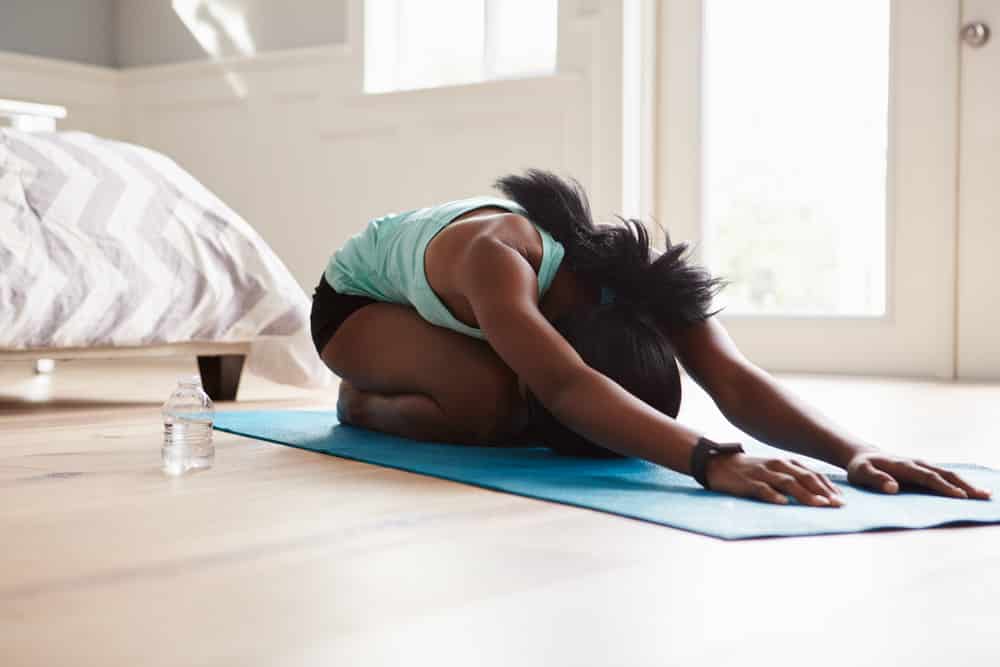
Bound Angle
This pose has a number of benefits, as well as releasing tension, including increasing flexibility around the hips and groin, especially if you have tight hips. Tension and stress is often stored around the hip area, so any work you do to stretch and release that area helps melt that stress away. Start by sitting up straight with your legs out in front of you. Fold your knees out to open your hips and place the soles of your feet together so that you’re making a diamond shape with your legs. Bring your heels in as close to your groin as you can without arching your back. Take hold of your ankles, or your feet and start to gently and slowly flap your knees up and down like a butterfly to help release any tension you might be holding. You can also sway from side-to-side, gently pressing your elbows into your inner thighs. If you can, move your chest towards the ground, leading with your heart, to get a deeper stretch around your hips. If you are particularly flexible, you can also walk your hands out in front of you and rest your forehead and chest on the mat, but don’t force this – it will come with time and practice!

Equestrian Pose
This is another pose that has benefits for flexibility and strength as well, but because it focuses on stretching and opening that hip and groin area again, it also comes with relaxation and tension-relieving benefits. Step your right leg back as far as possible, bending your left knee. Place the right knee down on the mat and place your fingers or palms down either side of your left foot. Sink your pelvis and groin forwards and downwards towards the ground and breathe through the tension for at least five breaths. Repeat on the other side.
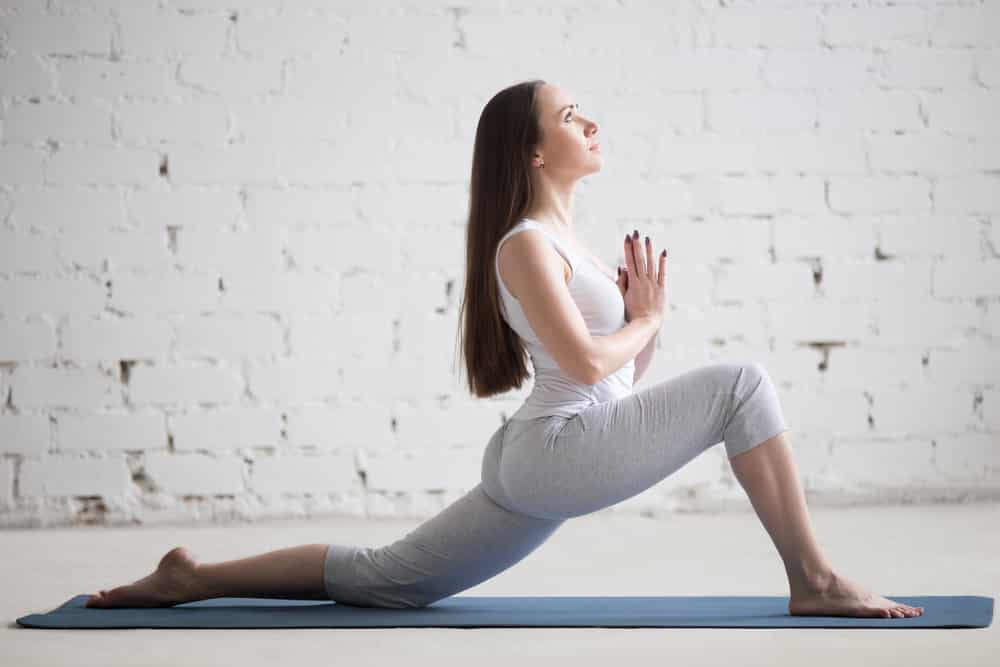
Wide-Legged Forward Fold
This pose stretches the backs of your legs, decompresses the spine and opens the hips, stretching that inner thigh and groin area again. Folding forward also helps melt away tension and relax the body. Have a yoga block ready in front of you in case you can’t reach your head to the ground, because it’s important to relax in this pose.
Start by standing with your legs wine in an upside-down ‘V’ shape. Slightly pigeon-toe your feet to internally rotate your thighs. Place your hands on your hips and lift your collarbone and chest upwards to lengthen your torso on an inhale. As you exhale, slowly fold forward, keeping your core strong and engaged, and your back straight, leading with your chest. Once you are halfway down, release your hands from your hips and black them on the block in front of you or on the mat. As you exhale, fold a little deeper, releasing the back, head and neck towards the ground, stretching and decompressing the spine. Rest the crown of your head on the block, or on the mat if it reaches, but, again, don’t force this – you are going to stay in this pose for a while and if it’s too intense, your body won’t relax and release its tension. Close your eyes if you feel balanced and hold the pose for 10 to 15 long, slow breaths. When you’re ready to come back out of the pose, engage your core, look forward, place your hands back on your hips and lift your upper body back up on an inhale with a straight back.
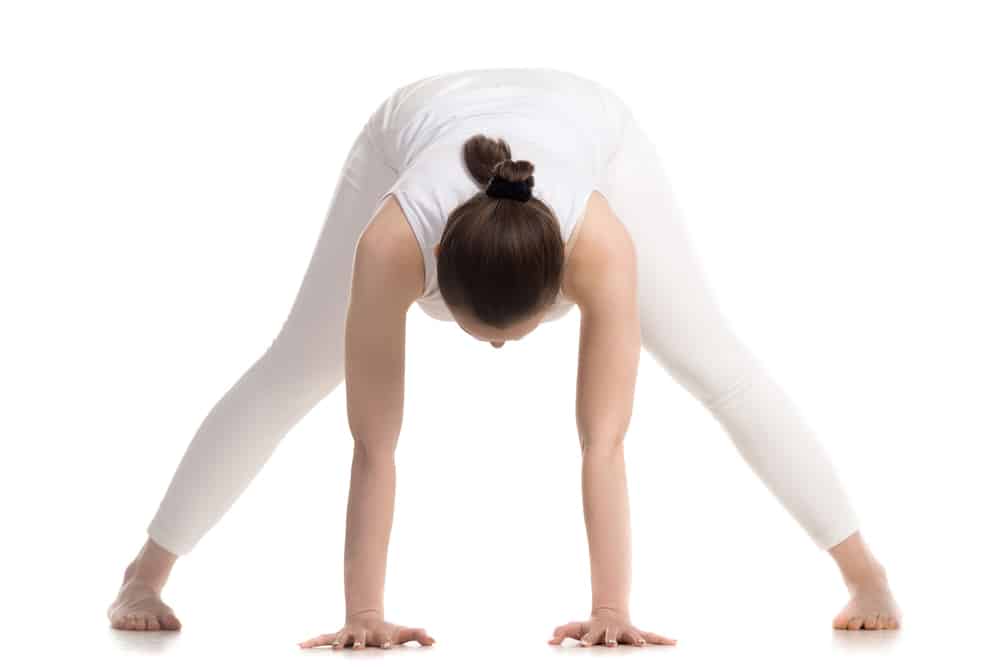
Seated Forward Fold
For seated forward fold, start in staff pose, sitting with your torso up straight and legs out in front of you. You can have a yoga strap ready if you are quite stiff to help you relax into the pose. Point your toes to the ceiling, lengthening the backs of your legs. Inhale, straightening your back and then as you exhale start to fold forward, leading with your chest. Slide your hands along your legs as you bed forward and either take hold of your strap, looping it around your feet, or, if you can reach, take hold of your feet. On your next exhale, release your head and neck so that your spine stretches and relax in the pose for 10 to 15 breaths. You can close your eyes and concentrate on your breathing.

Pigeon Pose
This pose is perhaps the best thigh stretch and hip opening posture you will find. It melts away tension and anxiety, relieves sciatica and improves flexibility around the entire hip area. Although it feels very intense while you’re in the pose, when you move out of it, you should feel more relaxed in general! Because it is a particularly strong pose, you need to make sure you are not cold when you move into it, so just make sure you’re in a warm room, or you’re warmed up from a shower or a bath. If you’re a beginner, have some folded blankets or cushions handy to prop you up. Start in tabletop position and bring your right leg forward in between your hands. Set the outside of your leg down on the mat with your lower leg crossing in front of your groin and opposite hip. Your right knee should be behind your right wrist and your right foot should be behind your left wrist. Depending on your level of flexibility, your leg might be on a bit of an angle back towards your groin. Never pick your leg up and force it to create more of an angle – again, it just takes time and practice. As you exhale, start to move your other foot backwards, getting your groin and pelvis closer to the mat. If you are falling to the right, place your blankets or pillows underneath your right glutes to ease the pose a little. Take long slow breaths and if the pose is particularly intense or uncomfortable, concentrate more on your inhales and exhales, imagining the oxygen reaching all the way down to your gluteus muscles on every inhale, releasing the tension from that area with every exhale.

If you feel comfortable at this stage, you can start to walk your hands forward, leaning your torso over your front leg and place your forearms on the ground. Hold here or keep walking your hands forward so that your arms are outstretched in front of you. Rest your forehead on the mat in front of your leg and start to relax into the pose, taking long, slow breaths. Stay here for at least 10 to 15 breaths, or more if you can manage it. Repeat on the other side.
Restorative Child’s Pose
Restorative poses are fantastic for melting away stress, slowing breath and preparing for sleep. We’ve already looked at child’s pose, and this one is similar, but uses restorative props. You can either use a large yoga bolster, a small beanbag or some pillows and yoga blocks. Regardless of what you have available, you still practice the pose in the same way. Place either the bolster, beanbag or blocks and pillows in front of you and straddle them with your legs. On an exhale, lay down over your prop, resting one cheek on the pillow or prop. Take a few active but slow inhales and exhales and then let go of your breath, relaxing and releasing deeper into the pose. Stay here for about one-and-a-half to two minutes and then gently lift your head, relaxing down onto the other cheek for the same amount of time.
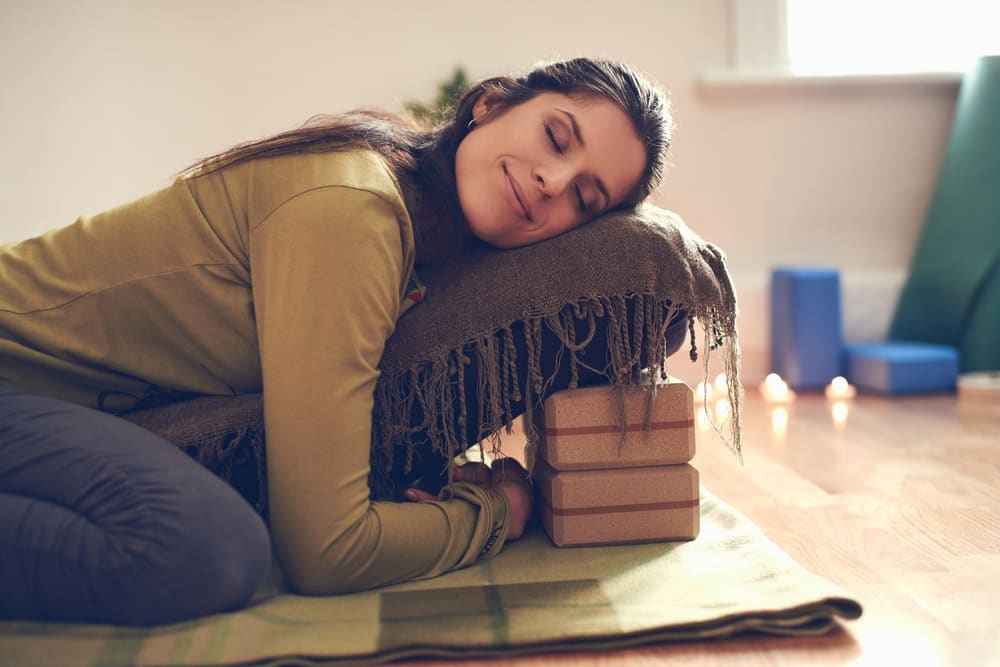
Corpse Pose
At this stage, you can lay in bed to practice corpse pose, or stay on your mat. Corpse is a meditative pose tat unwinds the whole body, calms the mind and relieves stress. It can also reduce headaches, fatigue and insomnia, as well as potentially lowering blood pressure. From restorative child’s pose, remove all your props and lay flat on your back. Give your body plenty of room, keeping your arms a little away from your body and about hip-distance between your feet. Allow your feet to flop out to either side and face your palms to the ceiling. Close your eyes and relax into the pose, taking long, slow breaths. You might drift off to sleep after this, or you should hopefully at least be relaxed enough to turn over a fall asleep.
